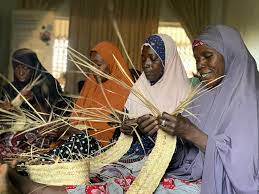
Until the late 1970’s when hydrocarbon was discovered in commercial quantity in Oloibiri, present day Bayelsa state, Agriculture remained the mainstay of the economy contributing over ninety percent (90%) of the gross domestic product (GDP) of the country as against the less than forty percent (40%) it now contributes with crop production accounting for an estimated eighty-five percent (85%), livestock ten percent (10%) and the balance made up by fisheries and forestry.
Any nation that requires economic development must look inwards to identify areas where it has comparative advantage over other nations and seek to develop the identified areas.
Apart from hydrocarbon, Nigeria has comparative in the Agricultural sector where a variety of products are produced due to the favorable climatic condition, good soil condition and the fact that over seventy percent (70%) of the entire land mass of the country is arable.
Nigeria has comparative advantage in the production cashew nuts, sesame seed and gum arabic in Africa over her counterparts due to the large arable land available for production and the condusive climatic condition.
Nigeria is the world’s second largest producer of cashew nuts, with an annual output estimated at nine hundred and sixty thousand (960,000) tonnes. Ninety-five percent (95%) of the annual production is exported as raw products.
In Nigeria, Cashew nuts are produced in twenty-eight (28) states of the Federation and the Federal Capital Territory (FCT). Nigeria’s cashew trading and export, is currently worth N 24 billion.
Cashew kernels are processed from raw cashew. The kernel has forty-seven percent (47%) fat (Eighty-two percent (82%) of which is unsaturated fatty acid), twenty-one percent (21%) protein and twenty-two percent (22%) carbohydrate.
This makes cashew kernel stand at per with milk, egg and meat. Due to its high content of unsaturated fatty acids in its fat composition, cashew kernels do not lead to obesity and high the carbohydrate content also makes it a good source of energy.
The cashew nut shell liquid (CNSL) or cashew shell oil (CAS registry number 8007-24-7) is a natural resin found in the honeycomb structure of the cashew nutshell and is a byproduct of processing cashew nuts.
Its composition varies depending on how it is processed. Cold, solvent extracted cashew nut shell liquid (CNSL) is mostly composed of anacardic acids (70%), cardol (18%) and cardanol (5%).
These substances are dermatogenic, like the oils of the poison ivy, and present danger during manual cashew processing.
It is a raw material of multiple uses in developing drugs, antioxidants, fungicides, etc. It is used in tropical folk medicine and for anti-termite treatment of timber.
Sesame (Sesamum Indicum) is a tropical and subtropical erect annual flowering plant that is cultivated for its seeds which grow in pods. Sesame seed comes in three colours in Nigeria and the colours are white, brown and black.
The brown and white sesame seeds are produced in commercial quantity in Nigeria and the white variety has the highest oil content. Sesame seed is flat in shape and one thousand (1,000) seeds weigh between four (4) and eight (8) gram depending on the variety, agronomy and climatic factors.
The economic value of sesame is the high oil content of the seeds ranging between forty to sixty percent (40%-60%).
Sesame seed is rich in methionine and cysteine, two amino acids that are not found in large amounts in leguminous food crops. Low cholesterol in sesame seed oil makes it an indispensable oil in the production of canned foods, margarine, cooking oil, pharmaceutical products, cosmetics and foods processing.
Sesame seed is used as a recipe for garnishing pastry and the cake obtained after extracting the oil is used for the formulation of animal feeds.
Sesame seed is the most sought after cash crop in Nigeria after cocoa. Nigeria is the second largest producer of sesame seed in Africa after Sudan and ranked seventh in the World.
Based on their colour difference, sesame seed in Nigeria can be classified into two (2) types namely the white/brown and black/mixed.
The white and brown varieties are usually regarded as the food grade and used in the bakery industry while the black varieties are referred to as oil grade and used in the production of sesame oil.
The white (Food Grade) seed is grown around the towns of Keffi, Lafia/Makurdi, Doma, and in Nassarawa, Taraba, and Benue States.
Sesame seed can also be hulled or unhulled. Sesame seeds have an exterior coat that can be removed. This coat is also known as the hull or the husk. The hulled sesame seeds are seeds with the hulls removed. The hulled seeds have a milder flavour that is nuttier than it is bitter.
The unhulled sesame seeds are those still in their natural state, which have their husk or hulls intact and not removed. Unhulled seeds have a crunchier texture compared with hulled seeds and may have a slightly more bitter flavour.
The demand market for sesame seed can be classified into two (2) broad groups namely that who buy because of the high-quality oil extractable from the seed and those who buy for non-oil use.
White seeds are a white-to-golden colour and receive a higher market price than mixed seeds, which range from yellow to dark brown.
White seeds are used primarily in natural or hulled form because of their aesthetic value, whereas mixed seeds are generally crushed into oil.
Black sesame seeds are an excellent source of magnesium and calcium and serve very well for non-dairy milk powders and other premium applications. The black seed is smaller than the white seed.
Sesame seeds (Sesamum indicum) are grown primarily for their oil content. The European market primarily uses sesame seeds for toppings on bakery products such as bread, bagels, hamburger buns and confectionery (sweets).
Sesame seeds are also used in snacks, salads (seed, dressings and sauces) and crackers, often in the form of sesame sticks. Restaurants and natural food consumers also purchase sesame seeds for use in food from various cuisines.
Nigeria is the largest producer of sesame seeds in Africa, and the secondlargest in the world, with about five hundred and eighty thousand (580,000) tonnes produced in 2019. Ninety percent (90%) of sesame seeds produced in Nigeria are exported.
Nigeria exports to China, Turkey, Japan, Vietnam and South Korea. Nigeria has only three (3) functional processing plants for sesame seeds (two in Kano and one in Lagos). Aggregate processing capacity of the three plants is three hundred (300) tonnes, with each producing one hundred (100) tonnes.
The poor number of functional processing plants has affected the quality of the seeds, as most seeds are processed manually. For a country that produces over one thousand, two hundred (1,200) tonnes per day, manual sorting and processing of these seeds are inefficient. It has also affected the pricing of the two (2) variants.
Currently, there are twenty-six (26) sesame-growing states in Nigeria; some of these include Ebonyi, Delta, Jigawa, Bauchi, Nassarawa, Benue and Taraba. The market for sesame seeds is quite vast with Japan and China as the major importers of these seeds. Countries like Turkey, India, Poland and Netherlands have also traded with Nigeria in the past.
Gum Arabic is a leguminous tree species that is well adapted to Sudan and Sahalian agro-ecology of Africa. There are over three hundred (300) species in this family. Notable among them is Acacia Senegal because it produces grade 1 quality gum. Its distribution is localized in Africa.
The gum is obtained as dry exudates from the stem and branches of Acacia Senegal and/or Acacia seyal when the plant is injured. The majority of Gum Arabic is produced from seventeen (17) African countries (Fourteen (14) of which were members of the NGARA network in 2007) in varying quantity and quality.
Nigeria has three (3) grades of Gum Arabic;
§ Acacia Senegal (grade 1)
§ Acacia Seyal (Grade 2)
§ Combretum (Grade 3)
The gum has a wide range of industrial uses especially, in areas of feed, textiles and pharmaceutical industries.
In food products, it serves as a stabilizer, emulsifier, and binding agent for chewing gums, ice creams and jams. In pharmaceuticals, the gum is a binder in iozenges, tablets, pills, throat pastilles and cough drops. In textile industry it is used for fabric stiffening and as a binder for textile printing gums; it is also used in the plastic industry.
In miscellaneous industries it is used in producing ink, water colours, paints, carbon papers, pottery glaces etc.
However, the main use of gum arabic remains in confectionery, hard gums, soft gum and gum pastilles. Presently Nigeria is the second largest producer and export of Gum Arabic in the world.






















